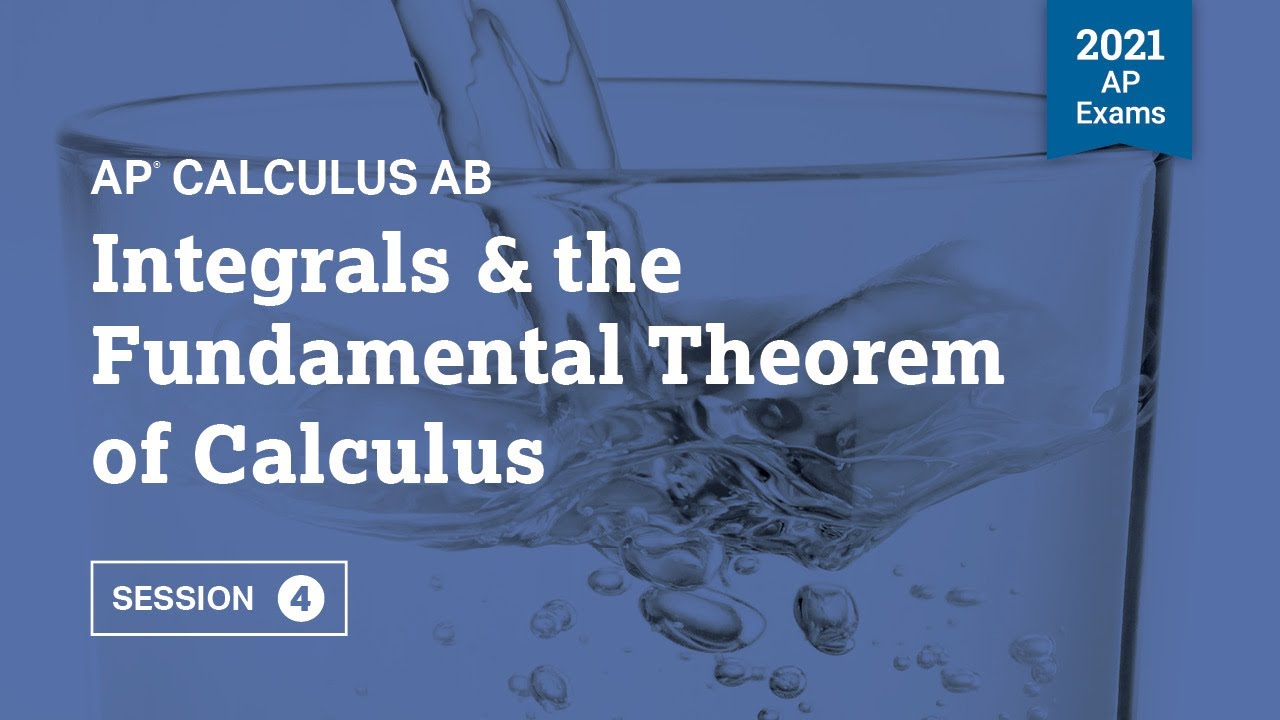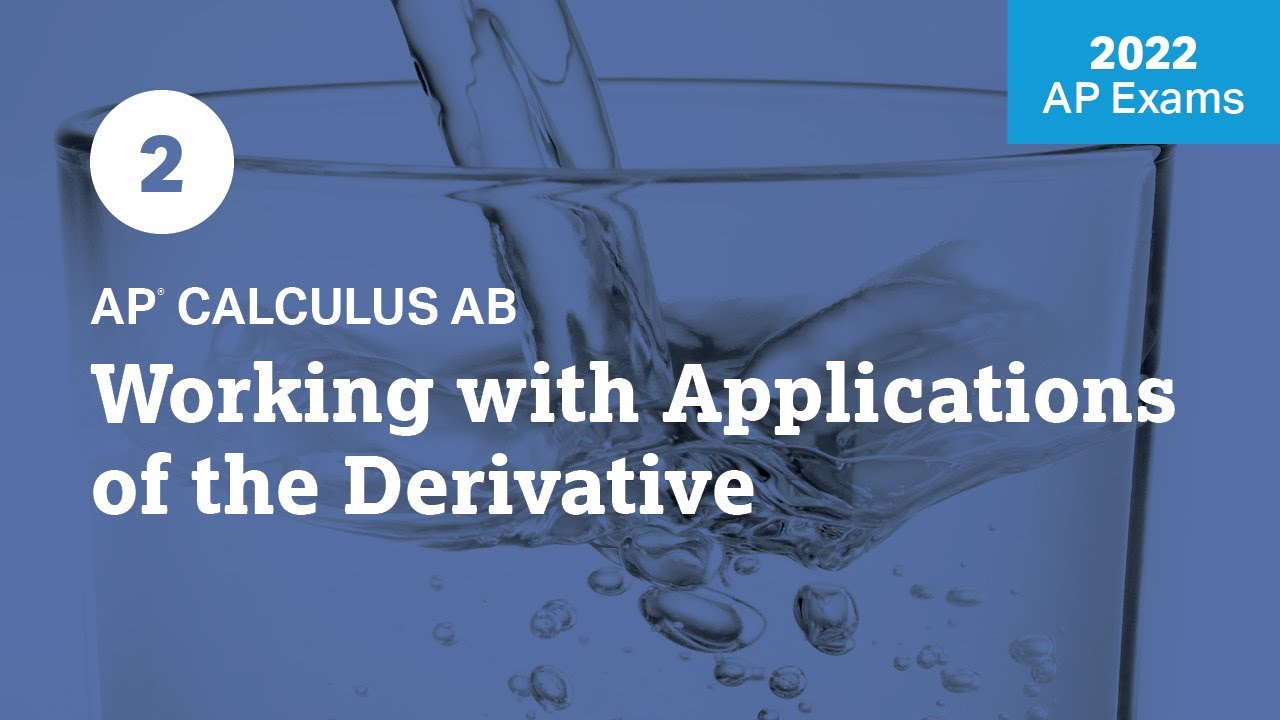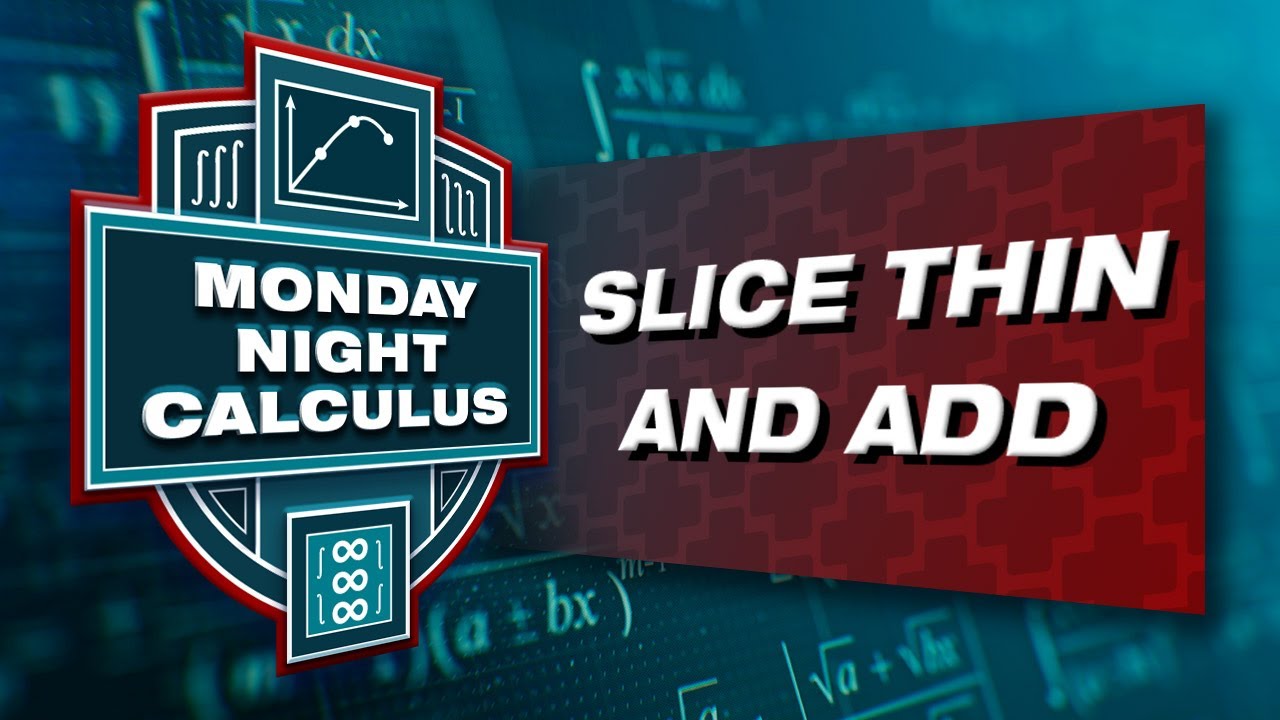2022 Live Review 4 | AP Calculus AB | Integrals & Using the Fundamental Theorem of Calculus
TLDRIn this engaging video, Mark Corelli and Virgin Cornelius, from their respective high schools in Denton, Texas, and Oxford, Mississippi, guide viewers through an immersive calculus lesson. The session, titled 'Calculus Day Four,' focuses on evaluating integrals and the application of the Fundamental Theorem of Calculus. They delve into the concept of integration as a means to calculate bounded areas, which can represent total change, especially when dealing with rates of change. The educators explore various methods, including Riemann sums for approximating integrals when exact equations are not available. They also discuss properties of definite integrals and the calculation of the average value of a function. The video is interactive, encouraging students to pause and solve problems on their own before continuing. The instructors provide a warm-up problem involving the evaluation of an integral and use a graph to illustrate the process. They also share a set of practice problems for students to work on, emphasizing the importance of daily practice. The session concludes with a reminder of upcoming topics, including significant theorems in calculus.
Takeaways
- 📚 **Evaluating Integrals**: The session focuses on evaluating integrals using the Fundamental Theorem of Calculus, which is essential for understanding the concept of integration as the accumulation of change over an interval.
- 🌟 **Riemann Sums**: Approximating integrals with Riemann sums is discussed, which is a technique used when an equation cannot be directly integrated or anti-differentiated.
- 🔍 **Properties of Definite Integrals**: The properties of definite integrals are explored, which are likened to puzzles that can be solved using various mathematical strategies.
- 📊 **Average Value of a Function**: The formula for finding the average value of a function is presented, which is calculated as one over the difference of the bounds times the integral from the lower to the upper bound.
- 🤔 **Multiple Representations**: The concept of multiple representations is touched upon, which refers to the various ways a mathematical problem can be represented or approached.
- 📈 **Graphing and Geometry**: The importance of graphing and understanding the geometric interpretation of integrals is emphasized, as it helps in visualizing the area under a curve.
- 🔢 **Practice Problems**: The instructors provide practice problems and encourage students to work through them, highlighting the importance of consistent practice in mastering calculus.
- ⏱️ **Time Management**: Strategies for managing time during problem-solving are discussed, such as focusing on simpler problems first to ensure they are completed accurately.
- 📐 **U-Substitution**: The technique of u-substitution is explained as a method for evaluating more complex integrals, by identifying a suitable substitution variable that simplifies the integral.
- 📉 **Removable Discontinuities**: The impact of removable discontinuities on integrals is covered, noting that these can often be ignored as they represent dimensionless points.
- 📝 **Note on Notation**: The instructors make a note about the use of notation in calculus, cautioning against the temptation to take shortcuts that could lead to mistakes.
Q & A
What is the topic of discussion for 'Calculus Day Four'?
-The topic of discussion for 'Calculus Day Four' is evaluating integrals and using the Fundamental Theorem of Calculus, including approximating integrals with Riemann sums, properties of definite integrals, and finding the average value of a function.
Why is the concept of Riemann sums mentioned in the context of data without an equation?
-Riemann sums are mentioned because they allow for the approximation of integrals when exact data is available but no explicit equation for the function is known, which is useful for estimating areas under curves or total changes when only discrete data points are available.
What is the significance of the Fundamental Theorem of Calculus in the context of this discussion?
-The Fundamental Theorem of Calculus is significant as it connects differentiation and integration, allowing the calculation of definite integrals by using the antiderivative of the integrand. It is a foundational concept for evaluating integrals and understanding the relationship between rates of change and accumulated quantities.
What is the purpose of the practice problems provided in the script?
-The practice problems are designed to give learners hands-on experience in applying the concepts of integrals, the Fundamental Theorem of Calculus, and related techniques to solve calculus problems. They are meant to reinforce learning and build problem-solving skills.
How does the script illustrate the process of evaluating a definite integral?
-The script illustrates the process by walking through the steps of setting up the integral, identifying the correct antiderivative, applying the limits of integration, and interpreting the result in the context of the problem. It also includes common mistakes to watch out for and the importance of checking one's work.
What is the role of geometry in understanding definite integrals?
-Geometry plays a crucial role in understanding definite integrals as it helps visualize the area under a curve, which the integral calculates. This geometric interpretation is particularly useful for understanding the properties of definite integrals and for solving problems involving the average value of a function.
How does the script address the concept of a removable discontinuity in the context of integrals?
-The script addresses removable discontinuities by explaining that the definite integral and the Fundamental Theorem of Calculus still apply, and that a single removable discontinuity (a 'hole' in the graph) does not affect the total area calculated by the integral because it is dimensionless.
What is the strategy suggested for solving integrals that involve functions resulting from a chain rule?
-The strategy suggested is to use u-substitution, where 'u' is chosen to be the more complicated part of the integrand that results from the chain rule. By doing so, the derivative of 'u' should simplify to a part of the integrand, allowing for easier integration.
How can one find the average value of a function on a given interval?
-The average value of a function on a given interval [a, b] is found by calculating the definite integral of the function from 'a' to 'b' and then dividing by the width of the interval (b - a). This gives the average value as (1/(b-a)) * ∫[a, b] f(x) dx.
What is the importance of the Mean Value Theorem and the Intermediate Value Theorem in calculus?
-The Mean Value Theorem provides a relationship between the average rate of change and the instantaneous rate of change of a function, stating that there exists at least one point where the instantaneous rate of change equals the average rate of change over an interval. The Intermediate Value Theorem guarantees that if a continuous function takes on two values at different points in its domain, then it takes on every value between those two values at least once, which is crucial for understanding the behavior of continuous functions.
What is the significance of the Squeeze Theorem in calculus?
-The Squeeze Theorem is used to find the limit of a function by 'squeezing' it between two other functions that have the same limit. If a function is bounded by two other functions that converge to the same limit, then the original function also converges to that limit. This theorem is particularly useful for finding limits that are not easily determinable through direct substitution or algebraic manipulation.
Outlines
😀 Introduction and Overview of Calculus Day Four
Mark Corelli and Virgin Cornelius, teachers from different high schools in Texas and Mississippi, greet each other and the audience. They discuss the weather and then introduce the topic for the day—evaluating integrals using the Fundamental Theorem of Calculus. The speakers cover various aspects such as Riemann sums, properties of definite integrals, and the average value of a function. They also present a warm-up problem involving the integral of a function and its graph.
📚 Practice Problems and Integral Evaluation Techniques
The instructors guide the audience through practice problems, emphasizing the importance of practice. They work on integrals, including a problem involving the integral of 2x to the fifth power. They discuss the use of the reverse power rule and the properties of definite integrals, such as factoring out coefficients. The conversation also touches on the concept of Riemann sums in the context of integral approximation.
🧩 Solving Definite Integrals and U-Substitution
The paragraph focuses on solving a complex definite integral using u-substitution. The speaker identifies the innermost function to simplify the integral and applies the technique to find the antiderivative. The solution process involves substituting the differential dx with an expression involving u, integrating, and finally selecting the correct answer from multiple-choice options.
🏞️ Geometry and the Fundamental Theorem of Calculus
The discussion revolves around the geometry of integrals and how the Fundamental Theorem of Calculus applies even with removable discontinuities. The speaker explains a problem involving the integral from negative 2 to 1, emphasizing the use of algebraic manipulation and anti-differentiation. The conversation also highlights the importance of understanding the geometric interpretation of integrals.
🔍 Inflection Points and Derivatives
The speakers explore a problem that requires finding the x-coordinate of a point of inflection on the graph of a function defined by an integral. They use the Fundamental Theorem of Calculus to find the first and second derivatives of the function and set the second derivative to zero to find the inflection point. The explanation includes a brief discussion on the behavior of the function around the inflection point.
📈 Indefinite Integrals and U-Substitution
The paragraph deals with the calculation of an indefinite integral involving a quotient. The speaker discusses the inability to simplify the integral using partial fractions or u-substitution due to the lack of a suitable derivative in the numerator. However, by recognizing the denominator as a perfect square, the speaker performs a u-substitution, integrates, and finds the correct answer.
🤓 Jokes, Property Problems, and Integral Calculations
The speakers share a calculus-based joke and then proceed to solve a property problem involving the integral of a function g from 3 to 5 and from 3 to 10. They use the properties of integrals to find the value of an integral from 5 to 10. The paragraph also includes a discussion on the average value of a function and a mistake made during the calculation process.
📝 Final Thoughts and Future Topics
The speakers wrap up the session by summarizing key takeaways and reminding the audience to practice daily. They mention that answer keys will be provided for the problems discussed and hint at future topics, including mean value theorem, intermediate value theorem, and the squeeze theorem. The conversation ends with a reminder for the audience to join them for the next session.
Mindmap
Keywords
💡Integral
💡Fundamental Theorem of Calculus
💡Riemann Sums
💡Definite Integrals
💡Average Value of a Function
💡U-Substitution
💡Chain Rule
💡Point of Inflection
💡Removable Discontinuity
💡Midpoint Sum
💡Left Riemann Sum
Highlights
The speakers are discussing a calculus lesson focusing on evaluating integrals and the Fundamental Theorem of Calculus.
They mention the importance of visualizing integration as the accumulation of area under a curve.
Approximating integrals with Riemann sums is discussed, particularly useful when an equation cannot be anti-differentiated.
The properties of definite integrals are described as being like puzzles that the speakers enjoy solving.
The concept of the average value of a function is explained using the integral formula.
A warm-up problem is presented involving the evaluation of an integral based on a given graph of a function g(t).
The speakers demonstrate the process of evaluating a definite integral by breaking it down into triangles and rectangles.
A method for evaluating integrals using the reverse power rule is explained with an example problem.
The concept of u-substitution is introduced as a technique for evaluating more complex integrals.
The importance of understanding the geometry of integrals is emphasized for a deeper grasp of calculus concepts.
A discussion on removable discontinuities and their impact on definite integrals is presented.
The speakers solve a problem involving the x-coordinate of a point of inflection using the Fundamental Theorem of Calculus.
A joke related to calculus is shared, lightening the mood and showcasing the speakers' humor.
The application of definite integral properties in solving a problem is demonstrated, highlighting the need for careful arithmetic.
The concept of average value in the context of a region bounded by a function is explored with an example.
The speakers caution against common mistakes when using definite integral properties, especially with products and quotients.
The use of different numerical methods (left Riemann sum, trapezoidal sum, and midpoint sum) for approximating integrals is discussed.
The transcript ends with advice on practicing calculus problems daily and a preview of upcoming topics, including the Mean Value Theorem.
Transcripts
Browse More Related Video

2021 Live Review 4 | AP Calculus AB | Integrals & the Fundamental Theorem of Calculus

2022 Live Review 2 | AP Calculus AB | Working with Applications of the Derivative

Fall 2023 MNC: Slice thin and add - Riemann sums and definite integrals

1 | MCQ | Practice Sessions | AP Calculus AB

8 | FRQ (No Calculator) | Practice Sessions | AP Calculus AB

5 | MCQ | Practice Sessions | AP Calculus AB
5.0 / 5 (0 votes)
Thanks for rating: